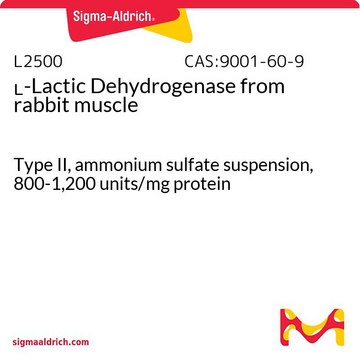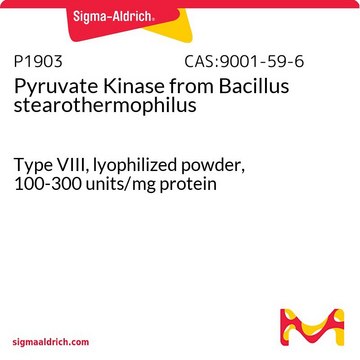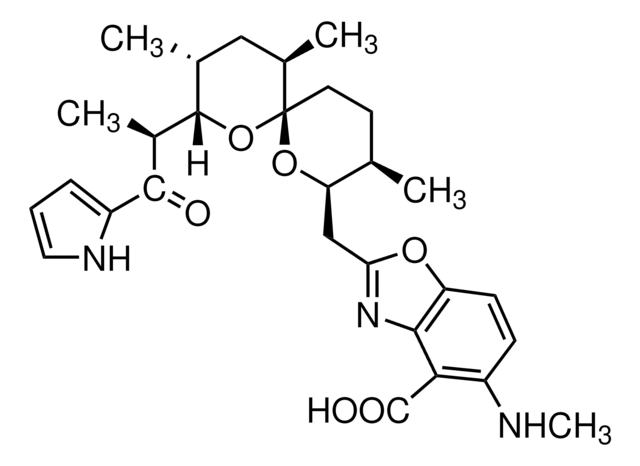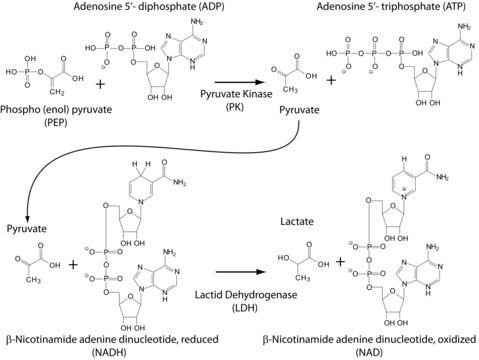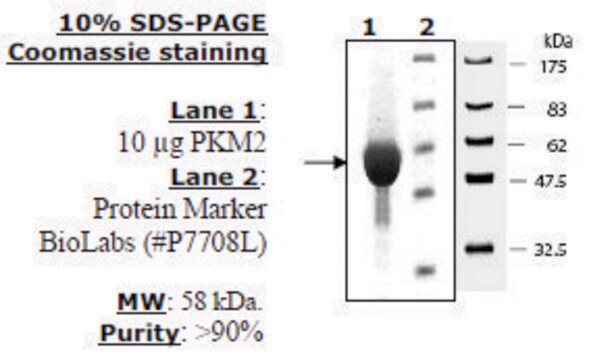P9136
Pyruvate Kinase from rabbit muscle
Type III, lyophilized powder, 350-600 units/mg protein
Synonym(s):
ATP:pyruvate 2-O-phosphotransferase, PK
Sign Into View Organizational & Contract Pricing
All Photos(3)
About This Item
Recommended Products
biological source
rabbit muscle
Quality Level
type
Type III
form
lyophilized powder
specific activity
350-600 units/mg protein
mol wt
237 kDa
foreign activity
lactic dehydrogenase, creatine phosphokinase, phosphoglucomutase, and myokinase ≤0.01%
storage temp.
−20°C
Looking for similar products? Visit Product Comparison Guide
General description
Pyruvate Kinase (PK) is a glycolysis enzyme and has four isozymes L, R, M1, and M2. The L isozyme is localized in gluconeogenic tissues, particularly in the liver. Whereas the R and M1 are localized in the adult skeletal muscles, heart, brain and erythrocytes, respectively. M2 is localized in the nucleus of the cells.
Application
Pyruvate Kinase from rabbit muscle has been used to convert adenosine diphosphate (ADP) to adenosine triphosphate (ATP) in Pseudomonas putida cells.
Pyruvate kinase has been used in plant spectrophotometric assays to measure ATP hydrolysis . Pyruvate kinase is also used to study pyruvate kinase (PK) deficiency .
Biochem/physiol Actions
Molecular Weight: 237 kDa and exists as a tetramer of four equal subunits of molecular weight 57 kDa.
Isoelectric Point: 7.6
Optimal pH: ∼7.5
Optimal Temperature: 25°C
ΕA280 = 0.54 for 1 mg(p)/ml, 1 cm path
Reported KM values are ATP (0.86 mM), pyruvate (10 mM), ADP (0.3 mM), and PEP (0.07 mM) in Tris buffer at pH 7.4 and 30 °C. Pyruvate kinase is highly specific for phosphoenolpyruvate, but can utilize other dinucleotide triphosphates as substrates in place of ATP including GTP, ITP, dATP, UTP, and CTP.
Isoelectric Point: 7.6
Optimal pH: ∼7.5
Optimal Temperature: 25°C
ΕA280 = 0.54 for 1 mg(p)/ml, 1 cm path
Reported KM values are ATP (0.86 mM), pyruvate (10 mM), ADP (0.3 mM), and PEP (0.07 mM) in Tris buffer at pH 7.4 and 30 °C. Pyruvate kinase is highly specific for phosphoenolpyruvate, but can utilize other dinucleotide triphosphates as substrates in place of ATP including GTP, ITP, dATP, UTP, and CTP.
Pyruvate kinase (PK) catalyzes an important process of transferring phosphate group from phosphoenolpyruvate (PEP) to adenosine diphosphate (ADP). This reaction results in the conversion of PEP to pyruvate and adenosine triphosphate (ATP). Pyruvate kinase plays a major role in glycolysis and gluconeogenesis. High levels of pyruvate kinase M2 (PKM2) inhibits cell proliferation and tumor growth. Deficiency of PK in red blood cells (RBC) leads to non-spherocytic hemolytic anaemia. In human erythrocytes, deficiency of PK induces a protective effect against Plasmodium falciparum.
Unit Definition
One unit will convert 1.0 μmole of phospho(enol)pyruvate to pyruvate per min at pH 7.6 at 37 °C.
Analysis Note
Protein determined by biuret.
Storage Class Code
11 - Combustible Solids
WGK
WGK 3
Flash Point(F)
Not applicable
Flash Point(C)
Not applicable
Personal Protective Equipment
dust mask type N95 (US), Eyeshields, Gloves
Choose from one of the most recent versions:
Already Own This Product?
Find documentation for the products that you have recently purchased in the Document Library.
Customers Also Viewed
Red cell pyruvate kinase deficiency: molecular and clinical aspects
Zanella A, et al.
British Journal of Haematology, 130(1), 11-25 (2005)
Hormonal control of pyruvate kinase activity and of gluconeogenesis in isolated hepatocytes
Feliu J E, et al.
Proceedings of the National Academy of Sciences of the USA, 73(8), 2762-2766 (1976)
[25] Pyruvate kinase isozymes from rat
Methods in Enzymology, 90, 150-165 (1982)
S P Robinson et al.
Plant physiology, 88(4), 1008-1014 (1988-12-01)
Ribulose 1,5-bisphosphate carboxylase/oxygenase (rubisco) activase protein was purified from spinach leaves by ammonium sulfate precipitation and ion exchange fast protein liquid chromatography. This resulted in 48-fold purification with 70% recovery of activity and yielded up to 18 milligrams of rubisco
Pyruvate kinase M2 activators promote tetramer formation and suppress tumorigenesis
Anastasiou D, et al.
Nature Chemical Biology, 8(10), 839-839 (2012)
Our team of scientists has experience in all areas of research including Life Science, Material Science, Chemical Synthesis, Chromatography, Analytical and many others.
Contact Technical Service




